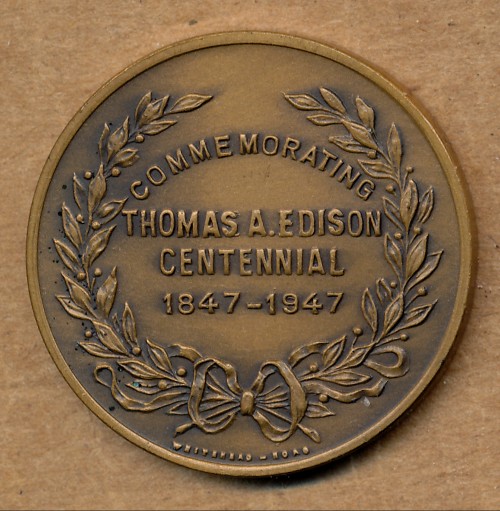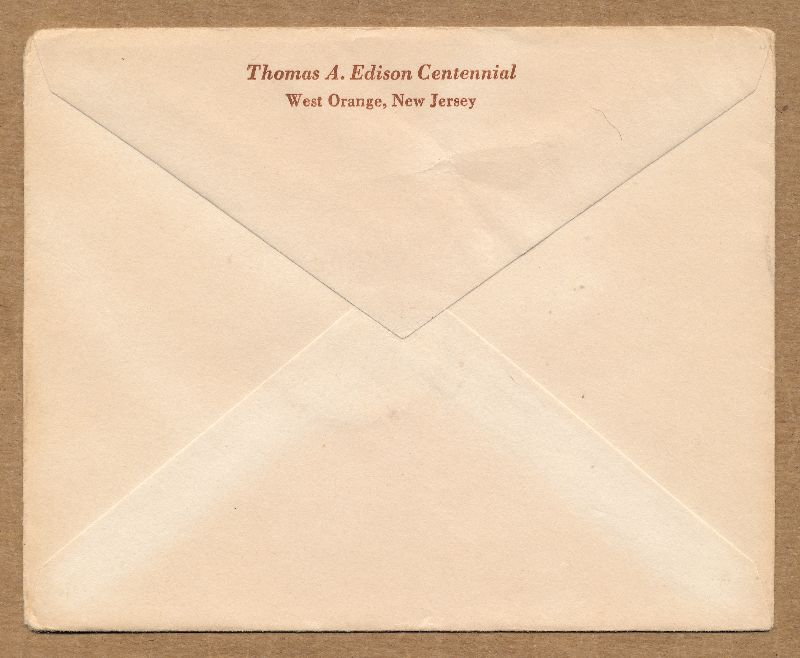Here's the first of three Thomas Edison medal posts I'm planning...The US Library of Congress opens its "Life of Thomas Alva Edison" article with:
"One of the most famous and prolific inventors of all time, Thomas Alva Edison exerted a tremendous influence on modern life, contributing inventions such as the incandescent light bulb, the phonograph, and the motion picture camera, as well as improving the telegraph and telephone. In his 84 years, he acquired an astounding 1,093 patents. Aside from being an inventor, Edison also managed to become a successful manufacturer and businessman, marketing his inventions to the public."How's that for an opening?! I guess it can be rather easy when the source material is so good!
Edison was born on February 11, 1847, in Milan, Ohio. He moved with his family to Huron, Michigan in 1854. Largely home-schooled, Edison showed an inquisitive and inventive nature from his early days. Though he essentially lost his hearing at age 12, Edison pressed on with his experiments and research.
Edison had multiple jobs (e.g., telegraph operator, machine repairman) before devoting his time fully to "inventing things" and working on his own (or in partnership). Much of his early work involved improving telegraph technology, something for which he earned several patents.
In the years that followed, Edison applied himself to telephony, phonographs, photography and, of course, electric light systems. (I'll discuss more of this in a future post.)
In 1947, Charles White, a Boston, Massachusetts coin dealer arranged with Whitehead and Hoag, a Newark, New Jersey firm that was known for its production of quality medals, badges and buttons, to strike a series of roughly half dollar sized commemorative medals (32 mm vs. the US half dollar's 30.6 mm) that could be marketed to collectors.
Note: The two men behind Whitehead and Hoag were Benjamin S. Whitehead and Chester R. Hoag.The medal series included five medals previously struck by W&H, two new Confederate replica medals and a new Edison Centennial piece. These medals were struck in nickel-silver (i.e., not silver, but an alloy of copper, nickel and zinc). Later, yellow brass examples were also struck.
To help mark the Centennial of Edison's birth, Thomas A. Edison, Inc. commissioned an antiqued bronze version of the medal. The obverse presents a right-facing Edison in profile with the inscription "THOMAS A. EDISON" below it. The medal's reverse design features a laurel wreath, open at the top, with the inscriptions "COMMEMORATIVE/THOMAS A. EDISON / CENTENNIAL/1847-1947" within it. Thomas A. Edison, Inc. was the "umbrella" (or holding) company for Thomas Edison's various companies; it operated from 1911 to 1957.
The medal was distributed in the leaflet and envelope shown. The medal appears to have been secured in the leaflet via two pieces of tape. Fortunately, the medal was placed in a clear cellophane pocket before being taped to the leaflet - this has generally (but not always) protected it from damage from tape residue.
The medal is not particularly scarce, but many have been separated from their original packaging.
1947 Thomas A. Edison Commemorative Medal
 1947 Thomas A. Edison Commemorative Medal - Leaflet
1947 Thomas A. Edison Commemorative Medal - Leaflet
 1947 Thomas A. Edison Commemorative Medal - Envelope
1947 Thomas A. Edison Commemorative Medal - Envelope

For more on Edison, and the 2004 Commemorative Silve Dollar that honored him, check out:
-
2004 Thomas Alva Edison Collector's Set-
2004 Thomas Alva Edison - 125th Anniversary of Light BulbFor more of my stories about commemorative coins and medals, see:
Commems Collection.
 Uncirculated American Silver Eagles
Uncirculated American Silver Eagles  My American Silver Eagle Proof Collection
My American Silver Eagle Proof Collection  Innovation Dollars
Innovation Dollars Kennedy-Half Dollars
Kennedy-Half Dollars  Washington-Quarters
Washington-Quarters  Roosevelt-Dimes
Roosevelt-Dimes  Buffalo-Nickels
Buffalo-Nickels  Jefferson-Nickels
Jefferson-Nickels  Lincoln-Cents
Lincoln-Cents

























